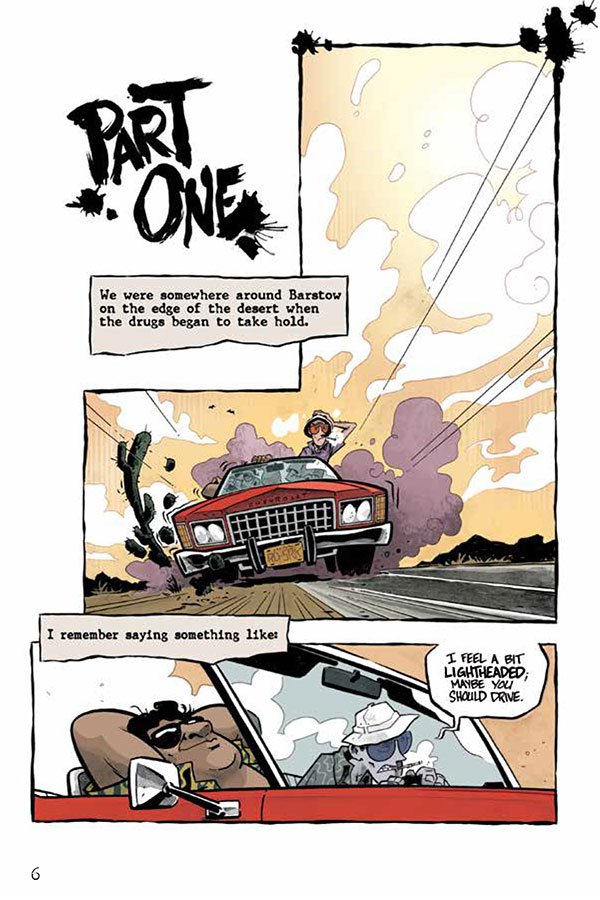Hunter S. Thompson’s iconic book Fear and Loathing in Las Vegas has been re-imagined in Troy Little’s graphic novel:



Hunter S. Thompson’s iconic book Fear and Loathing in Las Vegas has been re-imagined in Troy Little’s graphic novel:


Published on 28 Jul 2015
“I keep my mouth shut now. I’ve turned into a professional coward.”
– Hunter S. Thompson in 1967In the 1960s, Hunter S. Thompson spent more than a year living and drinking with members of the Hell’s Angels motorcycle club, riding up and down the California coast. What he saw alongside this group of renegades on Harleys, these hairy outlaws who rampaged and faced charges of attempted murder, assault and battery, and destruction of property along the way — all of this became the heart of Thompson’s first book: Hell’s Angels: A Strange and Terrible Saga. Shortly after the book came out, Thompson sat down for a radio interview with the one and only Studs Terkel.
CHOICE QUOTES
“I can’t remember ever winning a fight.”“I used to take it out at night on the Coast Highway, just drunk out of my mind, ride it for 20 and 30 miles in just short pants and a t-shirt. It’s a beautiful feeling.”
“ I tried to keep my eyes on him because I didn’t want to have my skull fractured.”
“They want to get back at the people who put them in this terrible, this dead end, tunnel.”
“The people who are most affected by this technological obsolescence are the ones least capable of understanding the reason for it, so the venom builds up much quicker. It feeds on their ignorance.”
The sporting editors had also given me $300 in cash, most of which was already spent on extremely dangerous drugs. The trunk of the car looked like a mobile police narcotics lab. We had two bags of grass, 75 pellets of mescaline, five sheets of high-powered blotter acid, a salt shaker half full of cocaine, and a whole galaxy of multi-colored uppers, downers, screamers, laughers … and also a quart of tequila, a quart of rum, a case of Budweiser, a pint of raw ether and two dozen amyls.
All this had been rounded up the night before, in a frenzy of high-speed driving all over Los Angeles County – from Topanga to Watts, we picked up everything we could get our hands on. Not that we needed all that for the trip, but once you get locked into a serious drug collection, the tendency is to push it as far as you can.
The only thing that really worried me was the ether. There is nothing in the world more helpless and irresponsible and depraved than a man in the depths of an ether binge. And I knew we’d get into that rotten stuff pretty soon. Probably at the next gas station. We had sampled almost everything else, and now – yes, it was time for a long snort of ether. And then do the next 100 miles in a horrible, slobbering sort of spastic stupor. The only way to keep alert on ether is to do up a lot of amyls – not all at once, but steadily, just enough to maintain the focus at 90 miles an hour through Barstow.
Hunter S. Thompson, “Fear and Loathing In Las Vegas”, Rolling Stone, 1971-11-11
At BoingBoing, Mark Frauenfelder reviews Gonzo: A Graphic Biography of Hunter S. Thompson by Will Bingley and Anthony Hope-Smith:
180 pages isn’t much room to examine a life in minute detail. Instead, Bingley tells a story (as if it were written, quite convincingly, by Thompson himself) of Thompson’s frantic search to find meaning in the turbulent era he lived in. Bingley’s story is about a passionate, rebellious genius who sprinted too fast at the beginning of a long-distance race, collapsed early, and spent his remaining decades burnt-out, crawling bewilderedly.
The book’s forward, written by Thompson’s longtime editor, Alan Rinzler, is especially revealing. Rinzler believes that Thompson could have been the “heavyweight champion of American letters,” but his self-destructive behavior, which got worse with each passing year, ruined that opportunity.
[. . .]
After Lono, says Rinzler, “Hunter’s substance abuse, writer’s block and brief attention span were increasing exponentially. He’s slip out to see his dealer and come back so tanked he couldn’t think straight.” Thompson’s work became a series of “repetitious, mediocre, regurgitated articles and books and collections he allowed to be issued and reissued over the last 30 years of his life.”
The Curse of Lono was the last book by Thompson I read, but I don’t doubt Rinzler’s assessment of the quality of Thompson’s books that followed. (Thompson’s awful “Hey Rube!” columns for an ESPN website were enough to keep me uninterested in his newer books). But his earlier work, especially Hell’s Angels, is so good that I will always admire Thompson as a heavyweight contender who showed a very promising start.
I eagerly read much of Thompson’s early work (Fear and Loathing in Las Vegas, Fear and Loathing on the Campaign Trail, The Great Shark Hunt, Hell’s Angels, and The Curse of Lono) in the early-to-mid 80’s, but tapered off soon after that. Several years ago, I picked up a remaindered copy of Hey Rube: Blood Sport, the Bush Doctrine, and the Downward Spiral of Dumbness Modern History from the Sports Desk and it was the literary equivalent of Rome after too many Goth and Vandal sackings: you could still see some great bits and pieces, but everything else had been broken, burned, hacked, and slashed.
Powered by WordPress